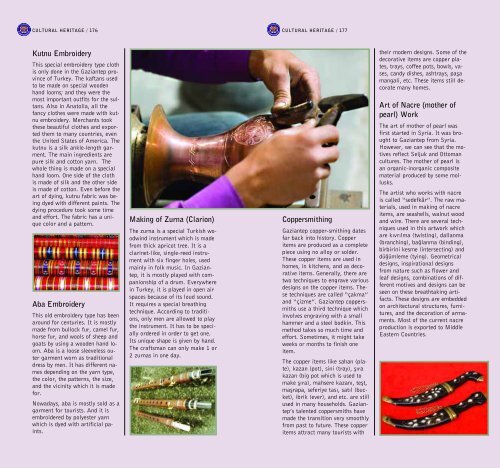You also want an ePaper? Increase the reach of your titles
YUMPU automatically turns print PDFs into web optimized ePapers that Google loves.
CULTURAL HERITAGE / 176<br />
Kutnu Embroidery<br />
This special embroidery type cloth<br />
is only done in the Gaziantep province<br />
of Turkey. The kaftans used<br />
to be made on special wooden<br />
hand looms; and they were the<br />
most important outfits <strong>for</strong> the sultans.<br />
Also in Anatolia, all the<br />
fancy clothes were made with kutnu<br />
embroidery. Merchants took<br />
these beautiful clothes and exported<br />
them to many countries, even<br />
the United States of America. The<br />
kutnu is a silk ankle-length garment.<br />
The main ingredients are<br />
pure silk and cotton yarn. The<br />
whole thing is made on a special<br />
hand loom. One side of the cloth<br />
is made of silk and the other side<br />
is made of cotton. Even be<strong>for</strong>e the<br />
art of dying, kutnu fabric was being<br />
dyed with different paints. The<br />
dying procedure took some time<br />
and ef<strong>for</strong>t. The fabric has a unique<br />
color and a pattern.<br />
Aba Embroidery<br />
This old embroidery type has been<br />
around <strong>for</strong> centuries. It is mostly<br />
made from bullock fur, camel fur,<br />
horse fur, and wools of sheep and<br />
goats by using a wooden hand loom.<br />
Aba is a loose sleeveless outer<br />
garment worn as traditional<br />
dress by men. It has different names<br />
depending on the yarn type,<br />
the color, the patterns, the size,<br />
and the vicinity which it is made<br />
<strong>for</strong>.<br />
Nowadays, aba is mostly sold as a<br />
garment <strong>for</strong> tourists. And it is<br />
embroidered by polyester yarn<br />
which is dyed with artificial paints.<br />
Making of Zurna (Clarion)<br />
The zurna is a special Turkish woodwind<br />
instrument which is made<br />
from thick apricot tree. It is a<br />
clarinet-like, single-reed instrument<br />
with six finger holes, used<br />
mainly in folk music. In Gaziantep,<br />
it is mostly played with companionship<br />
of a drum. Everywhere<br />
in Turkey, it is played in open air<br />
spaces because of its loud sound.<br />
It requires a special breathing<br />
technique. According to traditions,<br />
only men are allowed to play<br />
the instrument. It has to be specially<br />
ordered in order to get one.<br />
Its unique shape is given by hand.<br />
The craftsman can only make 1 or<br />
2 zurnas in one day.<br />
CULTURAL HERITAGE / 177<br />
Coppersmithing<br />
Gaziantep copper-smithing dates<br />
far back into history. Copper<br />
items are produced as a complete<br />
piece using no alloy or solder.<br />
These copper items are used in<br />
homes, in kitchens, and as decorative<br />
items. Generally, there are<br />
two techniques to engrave various<br />
designs on the copper items. These<br />
techniques are called “çakma”<br />
and “çizme”. Gaziantep coppersmiths<br />
use a third technique which<br />
involves engraving with a small<br />
hammer and a steel bodkin. This<br />
method takes so much time and<br />
ef<strong>for</strong>t. Sometimes, it might take<br />
weeks or months to finish one<br />
item.<br />
The copper items like sahan (plate),<br />
kazan (pot), sini (tray), fl›ra<br />
kazan (big pot which is used to<br />
make fl›ra), mahsere kazan›, teflt,<br />
maflrapa, seferiye tas›, sat›l (bucket),<br />
ibrik (ever), and etc. are still<br />
used in many households. Gaziantep’s<br />
talented coppersmiths have<br />
made the transition very smoothly<br />
from past to future. These copper<br />
items attract many tourists with<br />
their modern designs. Some of the<br />
decorative items are copper plates,<br />
trays, coffee pots, bowls, vases,<br />
candy dishes, ashtrays, pafla<br />
mangali, etc. These items still decorate<br />
many homes.<br />
Art of Nacre (mother of<br />
pearl) Work<br />
The art of mother of pearl was<br />
first started in Syria. It was brought<br />
to Gaziantep from Syria.<br />
However, we can see that the motives<br />
reflect Seljuk and Ottoman<br />
cultures. The mother of pearl is<br />
an organic-inorganic composite<br />
material produced by some mollusks.<br />
The artist who works with nacre<br />
is called “sedefkâr”. The raw materials,<br />
used in making of nacre<br />
items, are seashells, walnut wood<br />
and wire. There are several techniques<br />
used in this artwork which<br />
are k›vr›lma (twisting), dallanma<br />
(branching), ba¤lanma (binding),<br />
birbirini kesme (intersecting) and<br />
dü¤ümleme (tying). Geometrical<br />
designs, inspirational designs<br />
from nature such as flower and<br />
leaf designs, combinations of different<br />
motives and designs can be<br />
seen on these breathtaking artifacts.<br />
These designs are embedded<br />
on architectural structures, furnitures,<br />
and the decoration of armaments.<br />
Most of the current nacre<br />
production is exported to Middle<br />
Eastern Countries.


